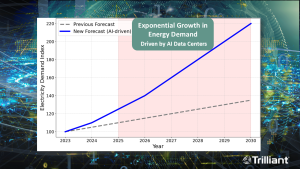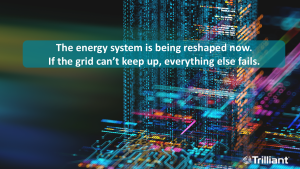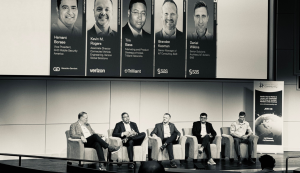
Blog
How IoT and Intelligent Infrastructure Are Powering the Energy Transition
During the June 2025 IoT Slam Conference in Cary, N.C., Jim Madej, President & CEO of Trilliant, delivered an afternoon keynote that was both timely and informative.
His message?
The electric grid—the backbone of our modern lives—is under unprecedented stress, and the Internet of Things (IoT) can be a key to its survival and evolution.
Electricity: The Unsung Hero of Modern Life
Madej opened with a light-hearted reminder: without electricity, there’s no Wi-Fi, no coffee, no streaming, and certainly no smart anything. But behind the scenes, the grid that powers our lives is aging and increasingly unable to meet modern demands.“We can probably take about 12–24 hours of an outage before we have real issues,” he shared recalling a moment of panic during a visit to a remote client with no cell service or Wi-Fi.
The Grid at a Crossroads
The U.S. electric grid, much of which was built in the mid-20th century, wasn’t designed for today’s two-way energy flows or the explosive growth in demand from electric vehicles, AI-powered data centers, and distributed energy resources.
Over 70% of distribution lines are more than 25 years old.
Utilities are now facing a perfect storm from:
- Aging infrastructure
- Surging demand from renewables, electrification and AI
- Cybersecurity threats
- Extreme weather and wildfires
- Data overload from millions of smart devices
IoT: The Backbone of a Smarter Grid
Madej emphasized that IoT is no longer a “nice to have”—it’s essential. This was a message repeated throughout the two-day conference held on June 24-25.
Smart meters, sensors, and edge computing are transforming how energy is monitored, distributed, and optimized.
Trilliant, with over 40 years in the energy industry and 37+ million endpoints deployed across 17 countries, is leading this transformation. Their work with Malaysia’s Tenaga Nasional Berhad (TNB) is a field-proven, standout example: deploying smart meters that provide real-time data, improve billing accuracy, and support Malaysia’s net-zero goals.

Ironically, the very technology promising to make the grid smarter, AI, is also one of its biggest stressors. AI-driven data centers are consuming massive amounts of power, with electricity demand projected to grow five times faster than expected between 2024 and 2029.
“AI is like that roommate who promised to help with the bills… and then left the AC on, the lights blazing, and charged 14 devices at once,” Madej joked.
To cope, many companies are bypassing the grid entirely. AWS, Microsoft, Meta, and others are investing in on-site power generation, including nuclear and natural gas, to ensure reliability and reduce strain on public infrastructure.
Six Imperatives for a Digital Grid
- Open Standards & Interoperability – No more closed systems.
- Hybrid, Scalable Networks – Adaptable to diverse environments.
- Edge Intelligence – Real-time, local decision-making.
- Open APIs & Collaboration – Innovation through partnership.
- Device-Independent Platforms – Flexibility and vendor independence.
- Regulatory Reform – Policies must evolve with technology.

“What started with 400 lamps in lower Manhattan is now a system under immense strain,” said Madej. “The challenges are big—but the creativity and innovation in this room are bigger.”
“At Trilliant, we’re excited to be part of this transformation. We’re committed to continuing to partner with other tech innovators and build the tools that utilities and smart cities need.”
He concluded, “Together, we can build a modern, open grid that powers opportunity.”
AIoT in Motion
Also during the conference, Tim Bass, a Global Solutions Manager at Trilliant, participated on a panel entitled, “AI-Driven IoT in Motion: Intelligent Connectivity, Edge Computing, and Security at Scale,” where he shared his insights on AI, Edge Computing, and Intelligent Connectivity that are transforming IIoT into AIoT.
“It’s a transformative time for the energy distribution ecosystem and Industrial IoT (IIoT) landscape. AI-powered edge computing, low-latency next-gen IIoT networks, and intelligent, cyber-resilient infrastructure are powering the intersection of AI and IIoT into AIoT,” expressed Bass.
“We are witnessing the ability of AIoT systems to collect, analyze, converge and execute actions on real-time data, autonomously, and directly at the edge where the data is generated. These systems are able to recognize patterns and integrate data from different sources to deliver faster, smarter decisions and automated actions.”
“What’s truly exciting is how AIoT systems are leveraging both Generative AI and Agentic AI to redefine IIoT use cases:
- Generative AI brings the power of pattern recognition and content creation to accelerate decision-making and predictive insights.
- Agentic AI enables autonomous execution to analyze data and take intelligent actions without human intervention.
These models are also redefining AIoT’s impact on grid modernization, edge devices, energy distribution, and industrial automation. As a result, this moves decision-making from reactive to proactive.”
Explore how Trilliant Smart Grid Solutions can help future-proof our critical infrastructure.
